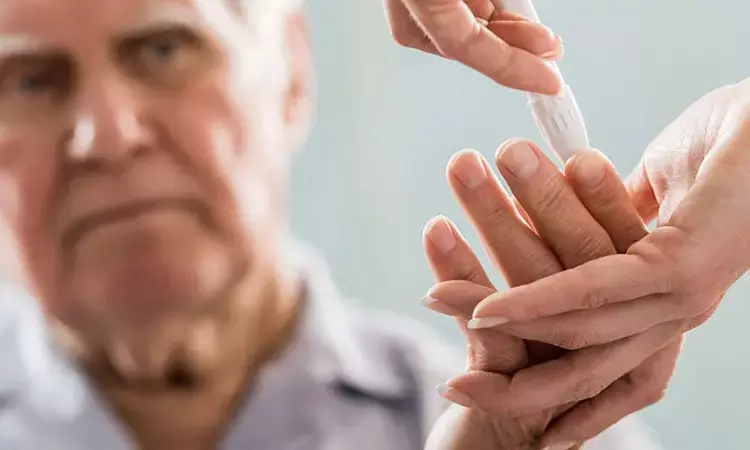- Home
- Medical news & Guidelines
- Anesthesiology
- Cardiology and CTVS
- Critical Care
- Dentistry
- Dermatology
- Diabetes and Endocrinology
- ENT
- Gastroenterology
- Medicine
- Nephrology
- Neurology
- Obstretics-Gynaecology
- Oncology
- Ophthalmology
- Orthopaedics
- Pediatrics-Neonatology
- Psychiatry
- Pulmonology
- Radiology
- Surgery
- Urology
- Laboratory Medicine
- Diet
- Nursing
- Paramedical
- Physiotherapy
- Health news
- Fact Check
- Bone Health Fact Check
- Brain Health Fact Check
- Cancer Related Fact Check
- Child Care Fact Check
- Dental and oral health fact check
- Diabetes and metabolic health fact check
- Diet and Nutrition Fact Check
- Eye and ENT Care Fact Check
- Fitness fact check
- Gut health fact check
- Heart health fact check
- Kidney health fact check
- Medical education fact check
- Men's health fact check
- Respiratory fact check
- Skin and hair care fact check
- Vaccine and Immunization fact check
- Women's health fact check
- AYUSH
- State News
- Andaman and Nicobar Islands
- Andhra Pradesh
- Arunachal Pradesh
- Assam
- Bihar
- Chandigarh
- Chattisgarh
- Dadra and Nagar Haveli
- Daman and Diu
- Delhi
- Goa
- Gujarat
- Haryana
- Himachal Pradesh
- Jammu & Kashmir
- Jharkhand
- Karnataka
- Kerala
- Ladakh
- Lakshadweep
- Madhya Pradesh
- Maharashtra
- Manipur
- Meghalaya
- Mizoram
- Nagaland
- Odisha
- Puducherry
- Punjab
- Rajasthan
- Sikkim
- Tamil Nadu
- Telangana
- Tripura
- Uttar Pradesh
- Uttrakhand
- West Bengal
- Medical Education
- Industry
Switching from intermittently scanned CGM to real time CGM improves QOL in T1 diabetes: Lancet

Recent research among an unselected adult type 1 diabetes population, switching from intermittently scanned continuous glucose monitoring (isCGM) to real-time continuous glucose monitoring (rtCGM) significantly improved time in range after 6 months of treatment, implying that clinicians should consider rtCGM instead of isCGM to improve the health and quality of life of people with type 1 diabetes. The findings have been published in The Lancet.
People with type 1 diabetes can continuously monitor their glucose levels on demand (intermittently scanned continuous glucose monitoring [isCGM]), or in real time (real-time continuous glucose monitoring [rtCGM]). However, it is unclear whether switching from isCGM to rtCGM with alert functionality offers additional benefits. Therefore, a team of researchers did a trial comparing rtCGM and isCGM in adults with type 1 diabetes (ALERTT1).
For the study, researchers did a prospective, double-arm, parallel-group, multicentre, randomised controlled trial in six hospitals in Belgium. Adults with type 1 diabetes who previously used isCGM were randomly assigned (1:1) to rtCGM (intervention) or isCGM (control). Randomisation was done centrally using minimisation dependent on study centre, age, gender, glycated haemoglobin (HbA1c), time in range (sensor glucose 3·9–10·0 mmol/L), insulin administration method, and hypoglycaemia awareness. Participants, investigators, and study teams were not masked to group allocation.
Primary endpoint was mean between-group difference in time in range after 6 months assessed in the intention-to-treat sample.
Findings highlighted some key facts.
- Between Jan 29 and Jul 30, 2019, 269 participants were recruited, of whom 254 were randomly assigned to rtCGM (n=127) or isCGM (n=127); 124 and 122 participants completed the study, respectively.
- After 6 months, time in range was higher with rtCGM than with isCGM (59·6% vs 51·9%; mean difference 6·85 percentage points [95% CI 4·36–9·34]; p<0·0001).
- After 6 months HbA1c was lower (7·1% vs 7·4%; p<0·0001), as was time <3·0 mmol/L (0·47% vs 0·84%; p=0·0070), and Hypoglycaemia Fear Survey version II worry subscale score (15·4 vs 18·0; p=0·0071).
- Fewer participants on rtCGM experienced severe hypoglycaemia (n=3 vs n=13; p=0·0082).
- Skin reaction was more frequently observed with isCGM and bleeding after sensor insertion was more frequently reported by rtCGM users.
- The researchers concluded that switching from intermittently scanned continuous glucose monitoring (isCGM) to real-time continuous glucose monitoring (rtCGM) with alert functionality offers additional benefits, improves outcomes and quality of life.
For full article follow the link: DOI:https://doi.org/10.1016/S0140-6736(21)00789-3
Source: The Lancet
Dr Satabdi Saha (BDS, MDS) is a practicing pediatric dentist with a keen interest in new medical researches and updates. She has completed her BDS from North Bengal Dental College ,Darjeeling. Then she went on to secure an ALL INDIA NEET PG rank and completed her MDS from the first dental college in the country – Dr R. Ahmed Dental College and Hospital. She is currently attached to The Marwari Relief Society Hospital as a consultant along with private practice of 2 years. She has published scientific papers in national and international journals. Her strong passion of sharing knowledge with the medical fraternity has motivated her to be a part of Medical Dialogues.
Dr Kamal Kant Kohli-MBBS, DTCD- a chest specialist with more than 30 years of practice and a flair for writing clinical articles, Dr Kamal Kant Kohli joined Medical Dialogues as a Chief Editor of Medical News. Besides writing articles, as an editor, he proofreads and verifies all the medical content published on Medical Dialogues including those coming from journals, studies,medical conferences,guidelines etc. Email: drkohli@medicaldialogues.in. Contact no. 011-43720751


